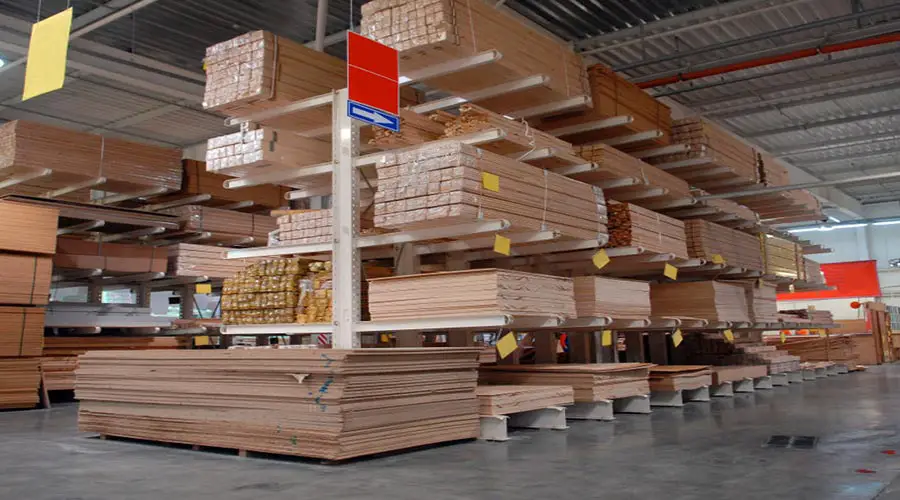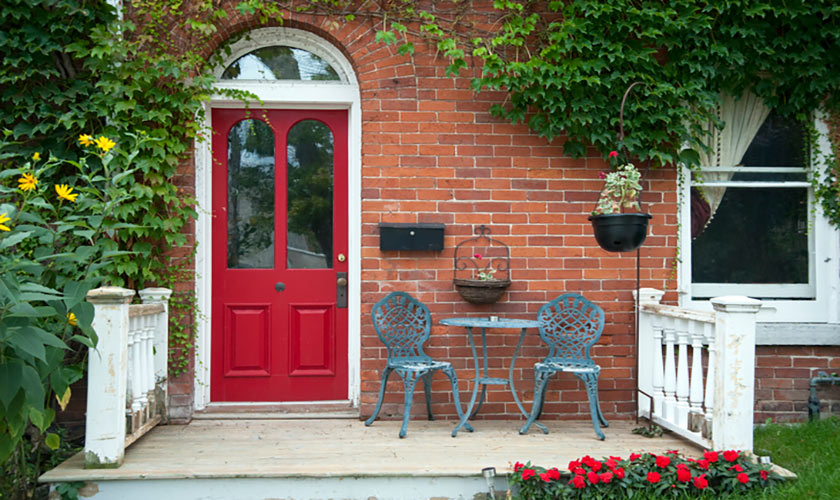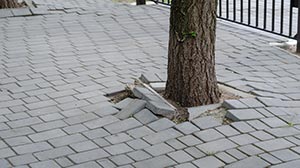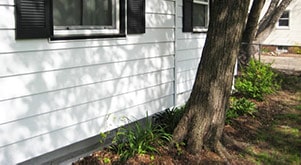
Cultivating trees close to a house improves the aesthetics and may even increase the property value. However, which tree species that are bad for foundations should you avoid?
Any large trees with robust, lateral, fast-growing root systems are bad for foundations. The worst tree species to plant near a house are oak, ash, and poplar trees. Smaller trees with less invasive roots are safe for growing near a house. Trim and maintain all tree roots to prevent foundation damage.
Many tree species are bad for house foundations, but some are worse than others. There are ways to keep house foundations safe from this type of damage, and there are trees that pose no threat. Let’s examine the damage caused to foundations by tree roots and discuss which trees are the most damaging to house foundations.
What Trees Should Not Be Planted Close to a House?
Trees that grow near a house have several advantages, such as windbreaks and shade on hot days, but in most instances, a large tree growing close to a house is likely to cause more damage than the advantages can outweigh. Some trees are worse than others, but which trees damage foundations and should not be planted close to a house?
Generally, it would be best if you did not plant trees with large, long, lateral-growing roots close to a house. These trees cause the most damage to foundations. Deciduous trees most commonly have these root systems, but some evergreen varieties are also dangerous for foundations.
There is an extensive list of trees that should not be grown anywhere near a house or any other building due to damage that they are likely to cause tree root damage to the foundation.
However, the list becomes smaller when considering the types of trees planted in residential gardens and even smaller when considering the trees growing well that close to a structure.
Here is a short list of which trees damage foundations:
| Water Oak | Carolina Poplar | Norway Maple | Loblolly Pine |
| Live Oak | Balm of Gilead Poplar | Silver Maple | Norway Spruce |
| Chestnut Oak | Ornamental Ash | Sweetgum | Swiss Stone Pine |
| Red Oak | White Ash | Sycamore | Walnut |
| Cottonwood Poplar | Carolina Ash | Tuliptree | Hickory |
| Lombardy Poplar | Black Locust | Brewer’s Weeping Spruce | Conifer |
| Eastern Poplar | Boxelder | Crimean Pine |
Other trees are likely to cause damage to the foundation of a house, but these are the most common culprits, as these trees are pretty common in many residential areas.
These trees share similar root systems, which have strong, fast-growing, deep, and lateral.
Many of these tree species require a lot of moisture, which is likely to cause subsidence in clay soil types.
Which Trees Cause the Most Damage Foundations?
Many species of trees grow root systems potentially damaging to house foundations, but which trees damage foundations more than others?
The most damaging trees to house foundations include oak, ash, and poplar trees. These species have the fastest-growing, strongest, and most invasive root systems of any trees grown in residential areas.
1. Oak Trees
Oak trees are the most damaging trees to house foundations. The number of oak trees grown in residential areas is very small, but oak trees account for more than 10% of foundation damage caused by tree roots.
The severe damage caused by oak tree root systems is because oak tree roots are large, strong, lateral, fast-growing, and surprisingly shallow for the size of the tree. Oaktree roots absorb large amounts of water, which means that they cause severe land subsidence.
2. Ash Trees
Ash trees are also responsible for damaging subsidence due to the moisture that ash tree roots absorb. Some ash trees grow 30 feet tall and have root systems up to 30 feet wide. These root systems will likely grow under foundations and force them upward, causing structural heaving.
3. Poplar Trees
Poplar trees have shallow, incredibly fast-growing root systems. Some poplar trees develop aggressive root systems that cause severe damage by forming cracks in foundations and sewage pipes.
Some ash trees can grow up to 100 feet tall. The size of these trees means they require more moisture than most, making their roots more aggressive, fast-growing, and more likely to force their way through foundation cracks in search of water.
These three tree species are the most damaging to house foundations. You should plant these trees far from buildings to avoid damaging the structure.

Which Trees are Safe to Plant Close to a House?
Some trees are safe for planting near a house. Some trees are excellent additions to a home and can drastically improve the house’s appearance and may even increase the property value. Small trees with non-invasive root systems are ideal for planting next to a house.
Small trees are much easier to maintain and far easier to cultivate. Still, a significant advantage to growing small trees near a house is that they tend to have shallow, non-invasive root systems that pose little to no threat to any structure.
The best trees to plant near house foundation include:
- Japanese Maple Tree
- Crabapple Tree
- American Hornbeam Tree
- Cornelian-Cherry Dogwood Tree
- Flowering Dogwood Tree
All these trees are safe to plant near a house, regardless of the size. These trees have root systems that are extremely unlikely to cause any damage to the house, are easy to maintain, and are all attractive trees that will increase the aesthetic appeal of any home.
Can a Tree Cause Foundation Problems?
Many houses have multiple trees growing nearby, and some have trees growing immediately beside the house. Problems caused by a tree growing too close to a house are not uncommon, but are these problems dangerous? Can tree roots cause foundation problems?
A tree growing too near to a house may cause damage to the foundation, and this can bring a huge problem afterward. Tree roots tend to grow outwards from the tree along the path of least resistance. If roots encounter a solid structure, they usually redirect, but if there is a flaw in the foundation, they are likely to exploit the opening.
Tree roots typically grow outwards and relatively close to the ground’s surface. Growing roots do not pose a threat if the tree is still small, but as the tree grows larger and more robust, the roots become more established.
The roots from smaller, younger trees are not yet hardened or strong enough to cause any actual harm to a house’s foundation. However, larger, older trees have more vigorous roots. These roots do not stop growing; the stronger they are, the more damage they are likely to inflict.
Tree roots always reach out further from the tree in search of moisture and nutrients. Still, when they encounter a solid foundation, the roots will usually divert in another direction, but if there is a pre-existing flaw in the foundation, such as a crack or a hole, the roots will likely grow into the space.
Once the roots have grown into the space, and if they are established and strong enough, they will widen the gap over time and grow directly through the foundation.
The roots are growing in search of moisture and nutrients. Moisture from stormwater runoff collects near the house’s foundation, making it the ideal environment for the roots to grow.
When the roots grow through the foundation’s structure, they are likely to cause severe damage by destabilizing the foundation or surrounding ground.
Damage to foundations by tree roots is the most common house foundation problem caused by tree roots, but growing tree roots can cause several issues.
For this reason, it is critical to closely monitor the root growth of any trees planted near a house and to take action against any roots that have the potential to cause any damage.
How Do Trees Damage Foundations?
There are multiple ways that tree roots can cause damage to a house’s foundation. The damage caused by tree roots can be light or severe, but you must attend to all of this before the problem becomes irreparable.
Tree roots cause damage to house foundations by causing subsidence, decreasing the foundation’s support, and causing cracks and holes in the foundation material. Some roots are strong enough to grow through the house’s foundation, compromising its structural integrity.
It can be hazardous to allow a large tree to grow near a house, as the roots are likely to cause serious harm to the building.
Let’s look more closely at the damaging effects of tree roots on the house’s foundation.
Subsidence Caused by Trees
Subsidence caused by tree roots is the most common damage inflicted by trees on houses. The National Oceanic and Atmospheric Administration defines land subsidence as the “gradual settling or sudden sinking of the earth’s surface.”
Subsidence occurs when a section of soil is compacted or shifts, causing the surface structure to change or destabilize. Another form of subsidence is when clay soil shrinks, which causes the ground’s surface to sink.
Tree roots are known to cause severe subsidence in clay soil types. As the roots grow, they absorb more moisture from the surrounding soil. The worst trees for subsidence are Oak, Ash, Poplar, Willow, and Sycamore.
In clay soil types, this moisture absorption causes the soil to shrink.
When clay soil shrinks due to subsidence, any structure built on or inside the ground will likely move or subside.
When the soil shrinks, it destabilizes the foundations’ support structure, and this can cause the foundation material to shift, settle, and crack.
This damage is directly caused by the growth and expansion of tree roots and is the leading cause of tree-related foundation damage.
Cracks, Holes, and Breaks
If the roots open the cracks, breaks, or holes far enough, the concrete sections in the foundation are likely to separate from the main block, shift, and cause various structural issues.
Tree roots are incredibly strong, and not much can hinder their growth if they spread uninterruptedly.
These roots are highly likely to exploit any crack, hole, or break they encounter in a house foundation. Given enough time, the roots will grow into openings and widen them. Eventually, the roots will cause the crack to rise to the foundation’s edge, severely compromising its structural integrity.
Roots Growing Through Foundations
If the roots are strong enough and allowed to grow for a long enough time, the roots may succeed in growing through the house’s foundation.
This is somewhat unusual, but it can happen. Tree roots can grow through cracks and openings in foundations caused by subsidence or other factors.
If the roots are allowed to grow through the foundation, this will likely render the foundation incredibly unstable and unsafe.
Damage of this type will require immediate repair before it becomes too severe for the building to be safely livable.
Roots Growing Under Foundations
What best tree distance from foundations should be considered before planting trees? If tree roots grow deep enough and far enough to reach below the foundations of a house, they are likely to force the foundation upwards.
Ideally, you should plant it at least half the distance of the tree’s mature canopy. Most trees have a 20 to 40-foot mature canopy. When you’re unsure about the diameter of the canopy, plant at least ten feet from a house.
If this occurs, the house’s foundations may heave, which causes severe structural damage to the building that is irreparable.
This damage is usually caused by deciduous trees, as their roots tend to be solid and long and grow deeply and laterally.

How to Tell if a Tree is Damaging Your Home’s Foundation
Damage caused by tree roots to house foundations is relatively common. There are several indications that trees’ roots are damaging foundations, and every homeowner needs to look out for these signs if trees are growing close to the house.
The most common indications of foundation damage caused by tree roots are:
- Uneven door or window frames
- Verticle cracks in basement or foundation walls
- Cracks in the foundation floor
- Buckled foundation floor surface
- Inexplicably broken windows
There are several causes for most of these issues, but encroaching tree roots likely cause the damage. If you identify any of these problems, contact a professional to determine if tree roots or other factors cause the damage.
If the roots have been able to cause this much damage, there is likely an underlying problem with the house’s foundation that requires urgent attention.
How to Prevent Foundation Damage from Trees
You can trim tree roots to prevent them from growing into house foundations. You can install root barriers to divert the roots away from the building. Installing a drip irrigation line at the tree’s base can prevent the roots from spreading too far out from the tree in search of water.
Trimming the roots of a tree is the best way to prevent the roots from causing damage to a house and its foundations. The other methods still have a slight risk of harming the house foundations, but physically removing the roots that grow too close will eliminate the problem.
This method will require the services of professionals, but trimming the roots must only be done periodically, and some trees will only require root trimming once a year, depending on how quickly the roots grow.
Root barriers are made from various materials, but they are all designed to keep roots from spreading into areas that may cause damage. Installing root barriers underground between the house and the tree is an excellent way to keep the roots from damaging the foundations.
Some root barriers need to be replaced over time as they may corrode or break down in the soil, but others are tough enough to remain in the ground for many years without needing a replacement.
This is a good, low-maintenance way to protect your house’s foundations from invasive tree roots.
Drip irrigation is an option for trees that require large amounts of water. Keeping the tree watered continuously at its base with underground drip irrigation will help to prevent the spread of the tree’s root system.
This method of root control is only applicable for specific trees, and there is no guarantee that the roots will not grow toward the house, but keeping the tree well-watered will help prevent the roots from spreading out in the search for moisture.
The best way to keep tree roots from damaging a house is not to grow damaging trees too close to the house, but trimming the roots is the next best method.
Can Removing a Tree Cause Foundation Problems?
Removing a tree is generally safe if you don’t uproot the tree. It’s best to cut the tree down and apply a stump killer to kill the tree roots, and after a few months, grind the stump away. By grinding the stump, you don’t disturb the deeper soil layers, which can increase settlement.
However, if you uproot the tree, there is a potential for damaging the foundation of your home. The roots of trees are very strong, and when they are pulled out of the ground, they can create cracks in the foundation.
In addition, when you remove a tree, you also remove the support that the roots provided to the foundation. This can cause the foundation to settle, leading to cracks and damage.
If you are planning on removing a tree, it’s important to consult with a professional first. They can assess the situation and determine the best course of action.
Conclusion
A tree growing near a house poses a threat to the integrity of the foundations of the building. Tree roots may cause the soil around or beneath the foundation to shift, which causes cracks in the concrete.
Some roots cause subsidence, usually in clay solid, which also causes the foundation to fain. These cracks and weak points allow areas from the roots to grow through, which may cause even more damage.
Tree roots that grow laterally can grow under the foundation of a house, lifting the foundation and causing severe damage to the structure of the building.
The worst trees to plant near a house are oak, ash, and poplar trees, as these species are the most likely to cause this type of damage to the foundations of a house.
Choosing a smaller tree with a non-invasive root system is the best option for planting near a house. Trees such as the Japanese Maple and the Crabapple tree are good options.
Trimming the roots and installing root barriers are the best way to prevent tree roots from damaging a house’s foundation.
At the end of it, try to avoid planting or cultivating large trees with fast-growing lateral roots, and keep any trees that grow close to the house well maintained and trimmed to avoid causing any damage to the house foundation.






